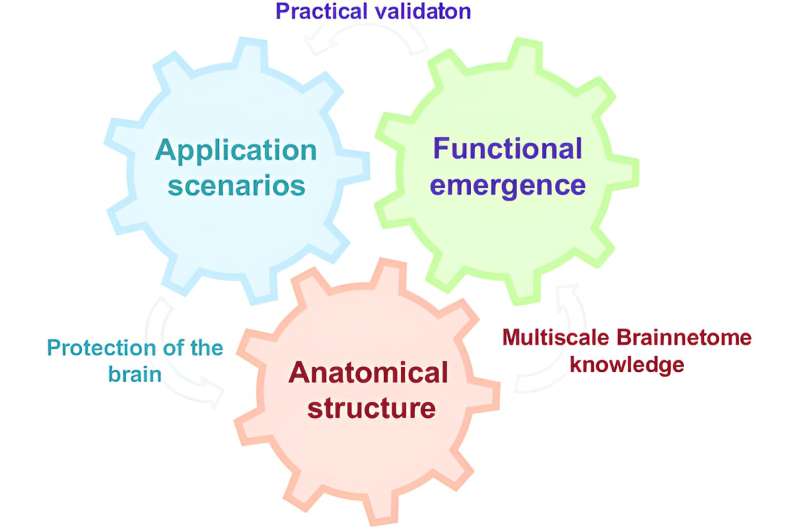This article has been reviewed according to Science X's editorial process and policies. Editors have highlighted the following attributes while ensuring the content's credibility:
fact-checked
proofread
Researchers plot a course for building a 'digital twin' of the brain

Recent developments in neuroscience and brain-inspired artificial intelligence have opened up new possibilities in understanding intelligence. Now, a research team led by Tianzi Jiang at the Institute of Automation of the Chinese Academy of Sciences has outlined the key components and properties of an innovative platform called the Digital Twin Brain, which could bridge the gap between biological and artificial intelligence and provide new insights into both.
This research was published in Intelligent Computing.
Network structure is something that biological and artificial intelligence have in common. Since the brain consists of biological networks, a digital model or "twin" of the brain built using artificial networks would allow researchers to feed knowledge about biological intelligence into the model. The ultimate goal is to "propel the development of artificial general intelligence and facilitate precision mental health care," a feat calling for joint efforts from interdisciplinary scientists worldwide.
Using the Digital Twin Brain, researchers could explore the working mechanisms of the human brain by simulating and modulating the brain in different states for various cognitive tasks. For example, they could simulate how the brain functions properly in a resting state and how it malfunctions in disorders, or develop methods to shift it away from an undesirable state by modulating its activity.
Despite sounding like science fiction, the idea of the Digital Twin Brain stands on solid biological ground. It integrates three core elements: brain atlases serving as the structural scaffolds and biological constraints, multi-level neural models trained on biological data to simulate brain functions, and a spectrum of applications for evaluating and updating the current "twin."
The three core elements are envisioned to evolve and interact in a closed loop. A dynamic brain atlas leads to improved neural models that generate more realistic function simulations. The current "twin," consisting of these models, is then validated across an ever-expanding spectrum of practical applications, including disease biomarker discovery and drug tests. These applications complete the cycle by providing feedback to enhance the brain atlas.
The biological brain has intricate structures and complex dynamics. Therefore, highly nuanced brain atlases, including atlases at different scales, of multiple modalities, and even from different species, are needed for learning how to build its digital twin. With a comprehensive collection of atlases, various aspects of the brain, and the connections and interactions between different brain regions, as well as the fundamental principles of brain organization, can be explored in depth.
On the other hand, brain atlases are also constraints in the sense that neural models must be based on them for "biological plausibility," and that poses technical challenges.
Jiang's team suggests that the Brainnetome Atlas will be an important component for developing the Digital Twin Brain. Announced by researchers at the Institute of Automation of the Chinese Academy of Sciences in 2016, this atlas is a macroscale atlas encompassing 246 brain sub-regions and has been evolving towards an "extensive and detailed mapping" of the structure and connectivity of the human brain.
Meanwhile, given that existing brain simulation platforms fall short of their anatomical basis, the authors believe it is vital to design "an open-source, efficient, flexible, and user-friendly brain atlas-constrained" platform that is powerful enough to support multiscale and multimodal modeling. There are still many open questions to be addressed, such as how to effectively weave bits and pieces of biological knowledge into a digital twin, how to design better models for simulations, and how to integrate the Digital Twin Brain into practical scenarios.
In summary, the Digital Twin Brain represents a convergence of neuroscience and artificial intelligence. By integrating intricate brain atlases, dynamic neural models, and a multitude of applications, this platform is poised to revolutionize our grasp of both biological and artificial intelligence.
With the collective efforts of scientists worldwide, the Digital Twin Brain holds the promise of advancing artificial general intelligence and revolutionizing precision mental health care, paving the way for transformative breakthroughs in our understanding of the human mind, the development of intelligent technologies, and the discovering of therapeutics for brain disorders.
More information: Hui Xiong et al, The Digital Twin Brain: A Bridge between Biological and Artificial Intelligence, Intelligent Computing (2023). DOI: 10.34133/icomputing.0055
















